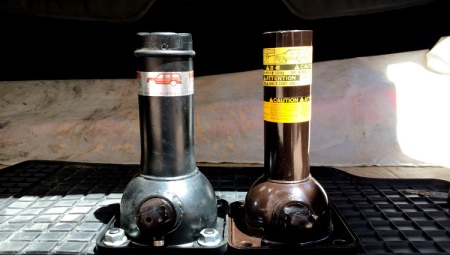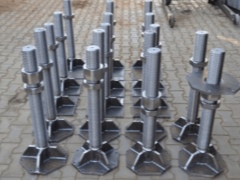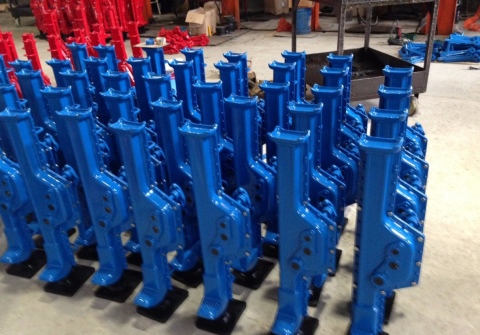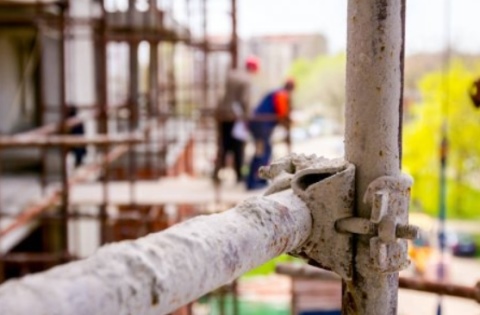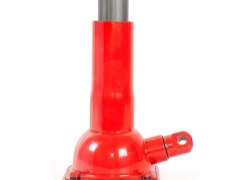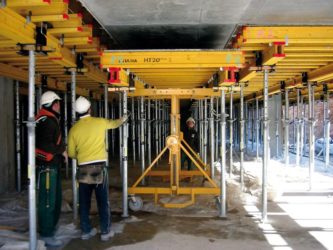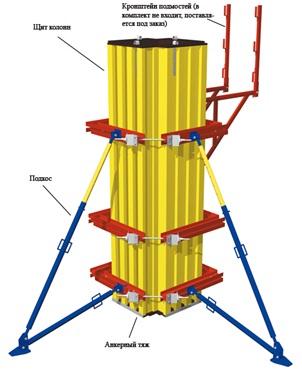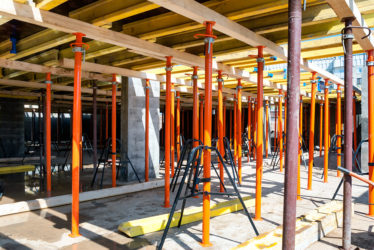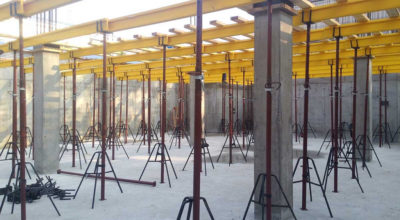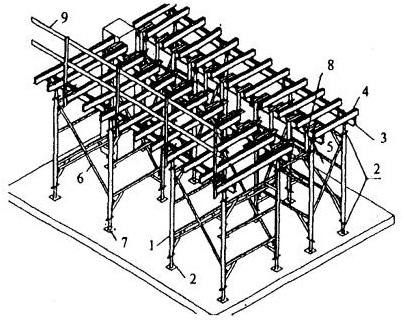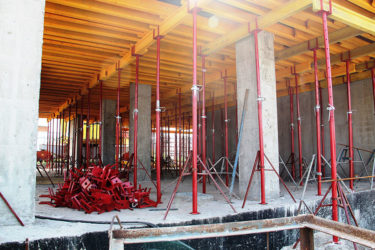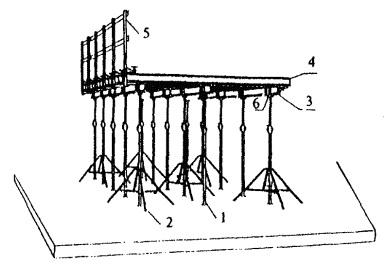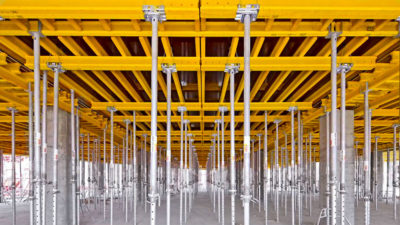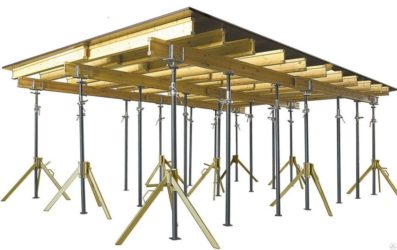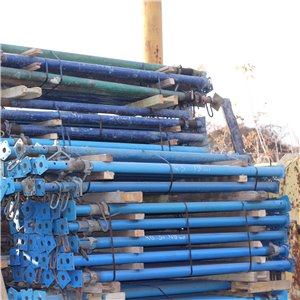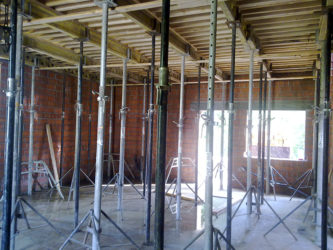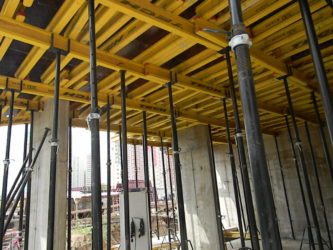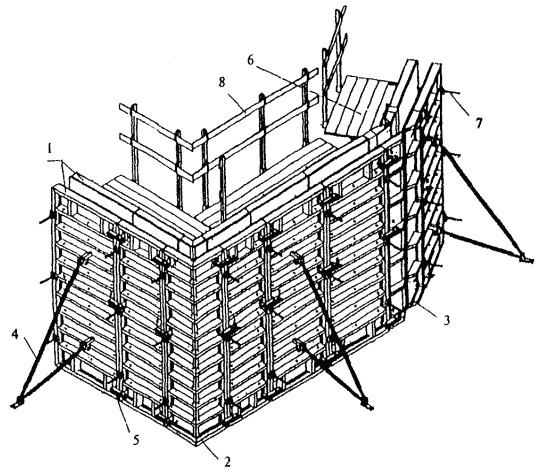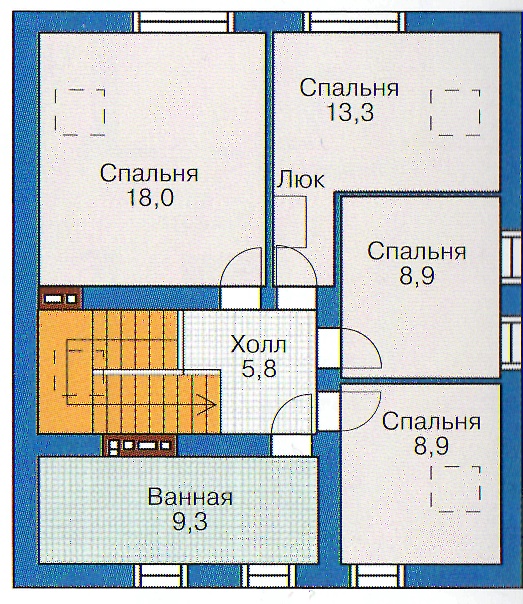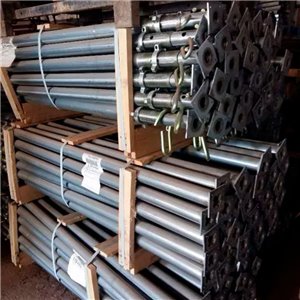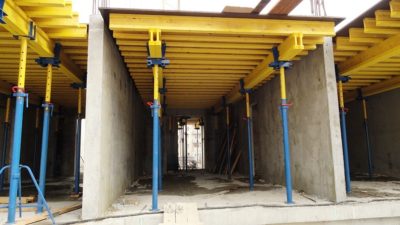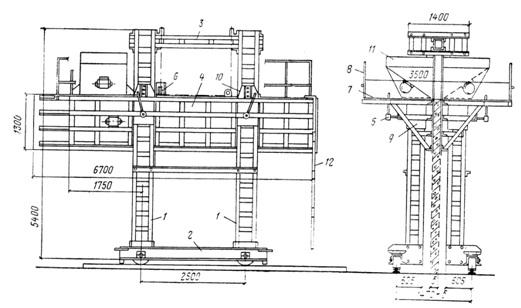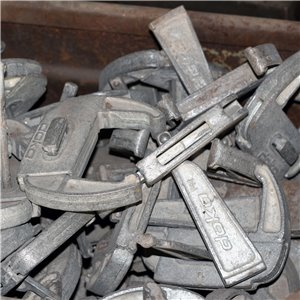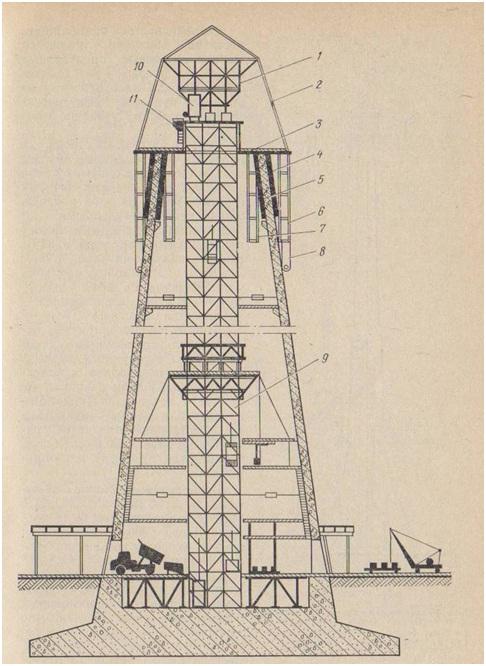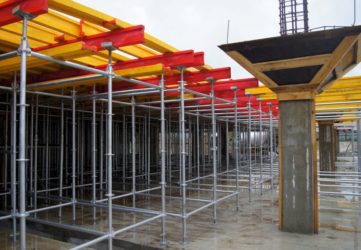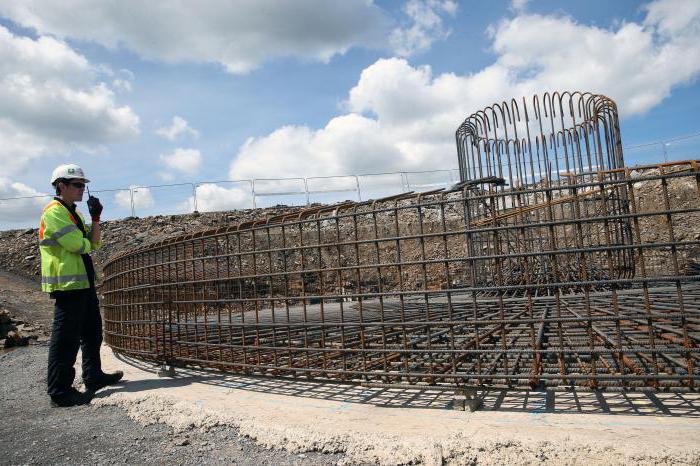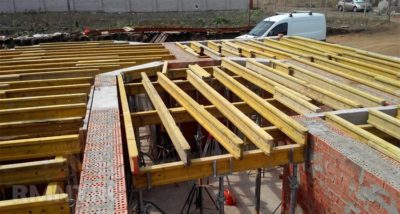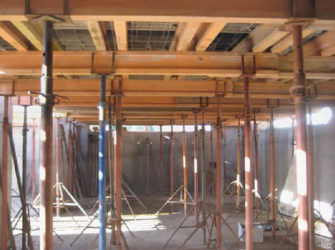Areas of use
Standard options for formwork systems are used when pouring slabs at a height of up to 3.1 m if the thickness of the last is not more than thirty centimeters. In this case, the diameter of the supporting elements will not exceed 6 cm, wall thickness - up to 2 mm... According to the calculations of the slab formwork on such telescopic racks, the supporting elements are set in relation to each other at a distance not exceeding one and a half meters.
Standard support legs can be divided by thread type:
supports with an open thread rolled onto the tensioning element. This technology makes it possible not to reduce the pipe diameter, but to give the support additional strength. The manufacturing methodology of this screw props for formwork almost eliminated the risks associated with a decrease in the strength of the structure. Such racks are considered to have a long service life;
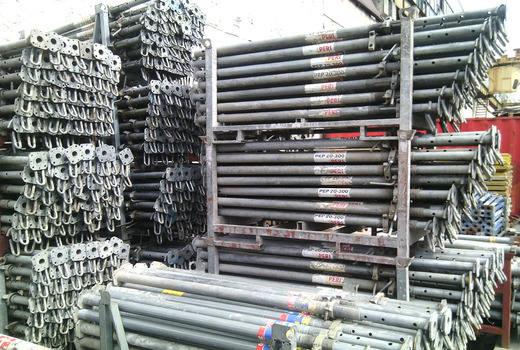
supports for monolithic structures with closed thread. This means that the tensioner has a special sleeve that reliably covers it from all kinds of blockages. From this, the service life and turnover in the use of floor formwork on telescopic racks increases by one and a half times.
This type of volumetric props for slab formwork is distinguished by a large diameter of the support element, up to 7.6 cm. In addition, the pipe wall thickness is 3 mm. These features allow the use of slab formwork on volumetric racks for the construction of structures, thickness which is 40 cm... Such racks are installed at a distance of up to 1 m, the type of thread is open.
All of these structures can be galvanized or painted. The first option is more popular, as it is less prone to wear and tear and lasts longer. Installation of all products is carried out using a similar technology.
Racks are considered universal elements of the formwork structure, and are used not only for exposing panels for pouring floors. They are actively used in repair and dismantling types of work at a considerable height, installed as supporting elements for sites that receive cargo. Only in this case, a reliable foundation should be poured under the pipe rack so that the site does not collapse.
Specifications
For the convenience of choosing racks for floor formwork, their main characteristics are given in the tables:
| Overlap dimensions in thickness and height | 3m / 30cm | 3 - 4.5 m / 30 - 40 cm |
| Rack type | Standard | Reinforced |
| Length, m | 3.1 – 4.2 | Up to 4.5 |
| Support diameter, cm | 6 | 7,6 |
| Pipe wall size in thickness, mm | 2 | 3 |
| Telescopic insert diameter size, cm | 4.8 – 5.1 | 6 |
| Insert wall thickness, mm | 2.5 | 3 |
| Rack installation step, m | 1.5 | 1 |

Rack sizes and weight:
| Telescopic rack name | Height, m | Dimensions of diameter and thickness, mm | Weight. Kg | |
| Interior | Outer | |||
| SD 2.1 | 1.2 – 2.1 | 60/2 | 51/2.5 | 9.44 |
| SD 2.5 | 1.4 – 2.5 | 10,6 | ||
| SD 3.1 | 1.7 – 3.1 | 11.87 | ||
| SD 3.7 | 2.0 – 3.7 | 13.74 | ||
| SD 4.2 | 2.5 – 4.2 | 15.17 | ||
| SD. 4.5 | 3.0 – 4.5 | 16.16 |
Technological features of the screw rack
Currently, the market offers screw telescopic supports of several modifications. They may differ in length (1.5 ... 2.9 m assembled, 2.5 ... 4.5 m disassembled), color and material of the screw assembly. The main support unit is manufactured by plastic deformation and thread rolling. For the production of the nut, high-strength cast iron is used, which is resistant to various loads. In some modifications of screw struts, the regulating unit is protected by a special casing (sleeve) that prevents dust and dirt from entering the thread.Several methods are used to protect the assembly from corrosion and environmental factors, including painting and galvanizing.
A kind of screw telescopic racks
28.04.2019
Stand elements
The first of them has a large diameter, is provided with a support platform from below, a tensioning element with threads and slots for fasteners is welded or put on to the opposite end. The telescopic tube has holes along its entire height with the same placement pitch of 11 - 17.5 cm. At one end there is also a platform that serves as a support for the formwork beam.
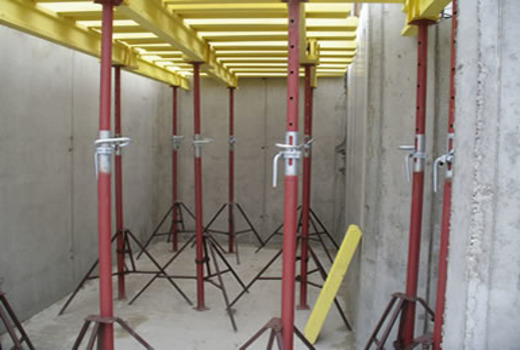
When assembling the racks, the supplied nuts or couplings are screwed onto the threads, after which the upper section can be installed. To fix the desired height, rods or earrings are used. Sometimes the set of racks does not include a fork and tripod. In this case, they are purchased additionally.
One-level and two-level struts
This type has two contact points: the first is in contact with the ground, the second is with the formwork shield. The maximum length of the factory single-level strut does not exceed 14 meters. These products can also be subdivided according to the method of height adjustment into screw and telescopic.
Various adjustment methods determine the advisability of using a specific model at an object with certain characteristics. That is, telescopic struts are relevant when working with structures not higher than 4.5 meters, while screw struts can be operated on formwork, the height of which is more than 14 meters.
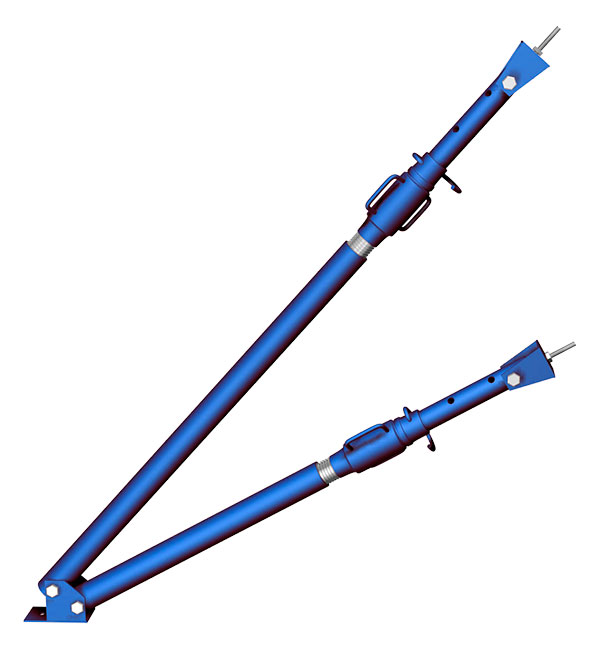
Telescopic double strut
Jack Element Standards and Specifications
All of them are all of them. ÃÂà° úÃÂøüà° à»ÃÂýà° àÃÂà° à± þÃÂà° àýà° óÃÂÃÂà· úà° ÃÂþþÃÂòÃÂμÃÂÃÂÃÂòÃÂÃÂÃÂÃÂμóþ ÃÂÃÂà° ýÃÂ'à° ÃÂÃÂà° ü ÃÂû ÃÂμüÃÂμýÃÂà° ýÃÂμ üÃÂμýÃÂμÃÂμ 4,95 ÃÂ. ࢠÃÂÃÂà± àøà· óþÃÂà° òà»Ã¸Ã²Ã ° ÃÂÃÂÃÂàò à· à° òþÃÂ'ÃÂúøàÃÂÃÂû þòøÃÂàÃÂ'ÃÂμÃÂþÃÂüà° ÃÂøþýýÃÂü ÃÂÿþÃÂþà± þü, ÃÂÃÂþ ÿþà· òþà»ÃÂÃÂμàþà± ÃÂμÃÂÿÃÂμÃÂøÃÂàýà° øà± þû ÃÂÃÂÃÂàÿÃÂþÃÂýþÃÂÃÂàø ÃÂÃÂÃÂþùÃÂøòþÃÂÃÂàú ýà° óÃÂÃÂà· úà° ü.

The first and the second, the second, the second, the second
ࢠÃÂÃÂμýþóà° à ¢  ÃÂà»ÃÂμüÃÂμýÃÂ, þà± ÃÂμÃÂÿÃÂμÃÂøòà° ÃÂÃÂøù ÿþòÃÂÃÂÃÂμýøÃÂμ ÃÂà° ÃÂà° úÃÂÃÂμÃÂøÃÂÃÂøú ÃÂþÿÃÂþÃÂøòû ÃÂμýøàÃÂà° à· ýþýàThe second half of the year, the second half of the second ÃÂà± ÃÂμÃÂÿÃÂμÃÂÃÂμýøÃÂμ ÃÂÃÂÃÂþùÃÂøòþÃÂÃÂø úþýÃÂÃÂÃÂÃÂúÃÂøø þà± ÃÂÃÂà»Ã¾Ã²Ã» ÃÂμýþ ýà° à»Ã¸ÃÂøÃÂμü ÃÂÃÂÃÂμàþÿþÃÂýÃÂàÃÂþÃÂÃÂμú, à° ÃÂà° úöÃÂμ öÃÂμÃÂÃÂúþù ÃÂøúÃÂàWe are in the middle of the day.
All of them in the second half of the year in the afternoon One half of one half of one half of one half of one half of the other. ࣠ýøòÃÂμÃÂÃÂà° à»ÃÂýà° àòøû úà° øüÃÂμÃÂμàóà° à± à° ÃÂøÃÂà3,25 * 2,14 * 1,34, ÃÂÃÂÃÂà° ýà° òà»Ã¸Ã²Ã ° ÃÂμÃÂÃÂàþýà° ýà° òÃÂμÃÂÃÂýÃÂàÃÂà° ÃÂÃÂàÃÂ'þüúÃÂà° ÃÂà° ø ÃÂøúÃÂøÃÂÃÂÃÂμÃÂÃÂàòøýÃÂþòÃÂü üÃÂμÃÂà° ýøà· üþü.
14.11.2016
What is a telescopic rack
The slab formwork device is directly the jack stand itself, a support fork and a tripod. The first element includes the following details:
- Lower guide support. It is a pipe with a diameter of 54 to 60 mm (with a wall thickness of 2 mm). On the lower part of the support there is a 120 x 120 mm welded platform. In the upper part of the product there is a special threaded nozzle, it plays the role of a tensioner (there are three types).
- Top support. It is made from a pipe with a diameter of up to 51 mm with a wall thickness of no more than 2.5 mm, on which special holes are drilled (at a distance of about 120 mm). Such perforation is necessary for the fixing brackets (also called "earrings"). In the upper part of the product there is a welded-on flange, which in its dimensions fully corresponds to the platform located on the lower support.
- "Earrings". These are special clips that are designed to hold back the top insert.
- Support nut. It moves along the tensioner to the desired distance and becomes an additional support for the upper supports.
The support fork (or unilk) is a sheet of metal measuring 325 x 214 x 5 mm. 4 vertical pipes (horns) with a square cross section are welded onto it. Their height is 134 mm. The univilka is installed on the upper support in order to fix the horizontal formwork I-beams.
The tripod (in the common people "skirt") is another part of the rack, consisting of 3 curved metal pipes. Thanks to this, the telescopic stand is positioned as smoothly as possible. In addition, the "skirt" allows you to significantly increase the resistance of the structure to dynamic loads, which usually occur during the pouring of concrete.

Healthy! Supporting the formwork during the construction of slabs is not the only function that products perform. The telescopic stand can also be used in the construction of raw material unloading sites or in the dismantling of horizontal parts of a building.
In this case, the telescopic support may differ in its length and type of thread. These nuances should be considered when choosing a supporting jack structure.
Rack types and applications
Telescopic formwork jacks are sold in several types based on their dimensions.
Standard formwork products are suitable for casting slabs up to a height of 3.1 m, provided that their thickness is not more than 300 mm. In this case, the diameter of the pipes of such support racks will be no more than 60 mm, and the wall thickness no more than 2 mm. Such products are usually installed at a distance of 1.5 m from each other.
Standard telescopic racks are subdivided according to the type of thread:
- STO (standard stands with open thread). In this case, the threads are rolled rather than cut onto the tensioner. Thanks to this, the pipe metal does not become thinner, but, on the contrary, becomes stronger. This method of manufacturing guides practically eliminates the risk of loss of product strength. Therefore, service stations last much longer.
- STZ (standard supports for monolithic floors with closed thread). This means that a special sleeve is located on the tensioner, which reliably protects it from any kind of contamination. Due to this, the service life and the turnover rate of structures increase by 1.5 times.
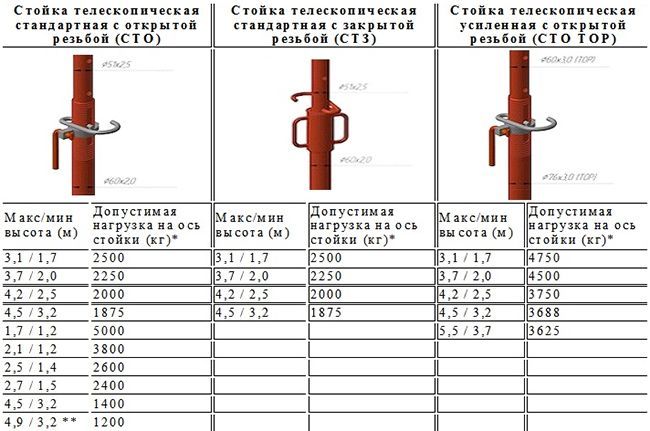
Also on sale there are reinforced telescopic supports designed for mounting ceilings up to 4.5 m high. Such structures are distinguished by a large support pipe diameter, which in this case is 76 mm. In addition, reinforced telescopic pipes are characterized by thicker walls (3 mm), which allows them to be used in the manufacture of slabs up to 400 mm thick. Structures of this type are installed at a distance of 1 meter from each other. If we talk about the type of thread, then reinforced products are made with an open type thread (STO TOP).

In addition, structures are galvanized and painted.The former are more popular due to their longer service life and durability. If we talk about ease of installation, then both products are mounted using the same technology.
Basic formwork components and tools
To create telescopic formwork, the following constituent elements are used:
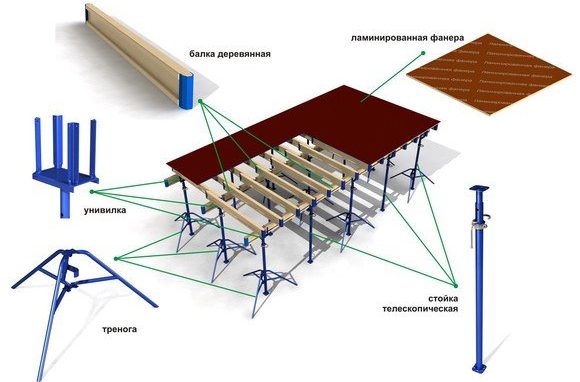
Elements for creating telescopic formwork
- telescopic racks;
- tripods;
- unvilka;
- wooden beams;
- the basis of the formwork in the form of plywood or polystyrene sheets;
- corners to create edges;
- level to control the work performed.
One support for the installation of floor formwork is able to withstand load up to two tons... These devices can be produced in various modifications, which is determined by the needs of the consumer. When building a small one-story house, it is advisable to use small elements with the possibility of extending the stem up to 3.1 m.
To create racks, pipes with a wall thickness of 2.3-2.8 mm are used. There are forged nuts at the top and bottom, which increase the rigidity of the structure. Tripods usually have a height of no more than 60 cm. The trolleys included in the telescopic racks can have different designs:
- the presence of four pins to hold the beams;
- the corner to which the beam is attached to increase the strength characteristics;
- the presence of a chute for a bar.
Telescopic stand what is it
Telescopic racks for slab formwork, arranged at a level of 1.7 - 4.5 m, are special telescopic supporting elements made of metal and adjustable in length. They can be bought or rented, engaged in the construction of interfloor structures of various configurations, horizontal slabs, flights of stairs with a thickness indicator varying within forty centimeters. The dimensions and the required amount are determined taking into account the estimated weight of the concrete mass to be poured and the height.
This is interesting: Do-it-yourself automatic chicken feeder: we will write in all the details
Telescopic props for slab formwork, design, characteristics and varieties
The formwork support consists of two steel or aluminum pipes different diameters. A support platform is welded to a pipe of a larger diameter from below, and from above - a nozzle with a thread rolled onto it and slots for fasteners. Some manufacturers cover threaded nozzles with sleeves to protect against contamination, according to this design feature, the racks are classified:
- with open thread;
- with closed thread.
The smaller pipe (telescopic insert) has holes along its entire length, distance between them from 110 to 175 mm, on top of it a support platform is welded to install the unilk. A support nut is screwed onto the nozzle of the lower pipe, a telescopic insert is inserted into it. The fixing of the required length of the rack is carried out with a special fastening shackle through the slots in the nozzle and holes in the upper pipe supported by a nut.
The dimensions of telescopic formwork racks are standard, they are produced in lengths from 1.7 to 4.5 m. The load that they are able to withstand ranges from 1 to 4 tons. To protect against corrosion, the formwork supports are painted with nitro-enamel or powder paint, individual parts are galvanized (threaded attachments, support nuts, fastening lugs).
List of required materials and devices for floor formwork
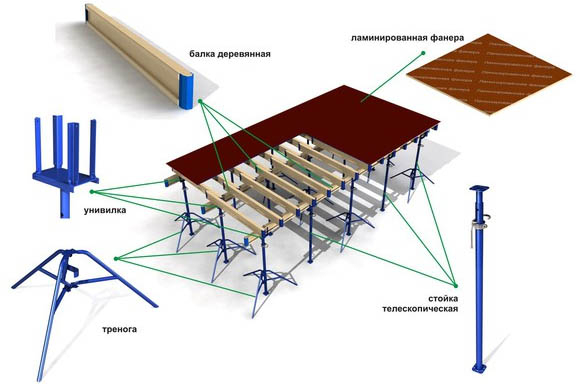
A simple slab formwork (for ceilings with a height of 1.5 - 4.5 m) consists of:
- telescopic supports;
- tripods - a device of three curved pipes, rigidly fixing the formwork stand in the desired position and taking on a part of the load;
- univilki - a metal sheet with metal pins, corners or a groove welded to it, intended for laying and fixing beams;
- wood beams;
- film faced plywood;
- reference angles,
- level.
Standard telescopic racks dimensions and weight.
| Name | Height | Diameter and thickness | Weight, kg | |
| min-max | Int. | Outside. | ||
| Telescopic stand SD 2.1 | 1.2 - 2.1 m | 60*2 | 51*2,5 | 9,44 |
| Telescopic stand SD 2.5 | 1.4 - 2.5 m | 10,60 | ||
| Telescopic stand SD 3.1 | 1.7 - 3.1 m | 11,87 | ||
| Telescopic stand SD 3.7 | 2.0 - 3.7 m | 13,74 | ||
| Telescopic stand SD 4.2 | 2.5 - 4.2 m | 15,17 | ||
| Telescopic stand SD 4.5 | 3.0 - 4.5 m | 16,16 |
Simple Slab Formwork Assembly - Seven Easy Steps
- Tripods are installed on a previously prepared surface, the clamps are raised to the stop.
- Telescopic racks are inserted into the tripods and fixed by lowering the clamps.
- Univilki are placed on the upper support platforms of the racks.
- The upper telescopic inserts are extended to the required height and secured with earrings for fastening.
- First, longitudinal, and then transverse beams are laid in the univilka.
- Level control the correctness of the position of the structure, adjust the height with support nuts.
- Set the support corners and lay the laminated plywood.
There are two types of telescopic racks - standard and reinforced. The differences are shown in the table:
| Height, floor thickness | up to 3 m, up to 300 mm | 3 - 4.5 m, 300 - 400 mm |
| Rack type | standard | reinforced |
| Rack length | 3.1 - 4.2 m | up to 4.5 m |
| Support pipe diameter | 60 mm | 76 mm |
| Support pipe wall thickness | 2 mm | 3 mm |
| Telescopic insert diameter | 48 - 51 mm | 60 mm |
| Telescopic insert wall thickness | 2.5 mm | 3 mm |
| Step between posts during installation | 1.5 m | 1m |
Structural elements
The main functional elements of the brace are: head, shoe and stem. Each of these elements plays a specific role in ensuring the stability of the formwork block:
- headrest - provides reliable fixation of the brace with the stiffening rib of the formwork panel;
- shoe - attached to the base and creates one of the horizontal load distribution nodes;
- rod - is the strut body, which carries the main load of the structure;
- universal headrest - an additional component required when operating the brace with various types of formwork systems.
Materials and tools required for installation
For a ceiling device at a height of 1.5 - 4.5 m you will need:
- telescopic supports;
- tripods - structurally consist of 3 curved pipes. With their help, the formwork props are rigidly fixed in the required position. In addition, a part of the load action is transferred to this element. Their use allows you not to fill the foundation for each rack;
- univilki - sheets of metal to which metal pins, a corner or grooves are welded, necessary for the installation and fastening of beams;
- wood beams;
- plywood with a laminated layer;
- support corners;
- building level, level.
Installation work
If the construction site is ready, tripods are set up on it, the stability of which is achieved by adjusting the swivel elements. The profile metal pipe not only holds the support vertically, but also partially takes the load. The clamping device is lifted up to the stop, and as soon as the adjustment of the adjustable support is completed, it is lowered again to fix the support tube.
> On the platform on top, a unilk is placed, the section is pushed to the required height, fixing it with an earring. Installation work is performed in a specific sequence:
- first the longitudinal beams are exposed, then the transverse ones;
- the location is checked on the horizontal level;
- the formwork base is leveled by adjusting the height of the supports, for which special nuts are used;
- laminated plywood sheets are laid;
- using the level, the horizontal position is checked. If necessary, the position of the supporting elements is changed;
- shield elements of the formwork are mounted at the edges;
- a reinforcing base is installed.
In most cases, the step of installing the racks is one and a half meters, but such parameters are advisory in nature - you should take into account the features of the design documentation for construction work
In addition to the mass of concrete mortar, reinforcement, equipment required for concrete work, the workers involved, the formwork structure itself, the parameters of the height at which the floor is poured should be taken into account, the calculation of the foundation for the support post should be clarified

Most construction companies provide potential buyers with the necessary calculations free of charge. In order not to make a mistake, it is necessary to select the correct telescopic racks, not only in terms of quantity, but also in size. The most popular option is the foundation stand to 2 7 46.
Design features of the screw rack
The support with a screw pair is designed for fine adjustment of the height characteristics of the formwork. General requirements for this type of support are regulated by GOST 15150-69. The support consists of two tubular components - an internal and an external one, on the external tube there are several technological holes designed to fix the internal component. The inner tube (smaller diameter) also has holes through which it is fixed to the outer component as it climbs to the desired height.
A screw assembly, consisting of a threaded element, a nut and a wedge, acts as a fixing mechanism. The screw element is equipped with a through hole in which a wedge is installed to fix the position of the inner support. Rotating the screw in an already fixed position allows you to more accurately adjust the height of the support and align the vertical of the structure as a whole, adjusting each of the elements separately.
Views
In order to carry out the lifting of the load during the implementation of construction and installation and repair and finishing works, in addition to the hoists themselves, jacks are widespread. They are especially relevant in cases where a low lifting height is technologically required. In construction practice, they use a screw jack, rack and pinion, as well as hydraulic or pneumatic types. Such equipment is used for vertical transportation of goods or holding large-sized items, structures and even buildings during any technological and construction operations.
The most primitive screw jack includes a trapezoidal or rectangular threaded body. On the upper part of it there is a head, which is responsible for maintaining the raised soil. The ratchet wheel fixes the head, the screw covered by the clamp is set in motion by the handle and the double-sided pawl fixed on the axle. In this position of the pawl, a spring fixed to the handle is fixed.
All screw jacks are adjustable and self-braking systems, so their lifting angle, as a rule, does not exceed 5 degrees. The lifting capacity of typical construction jacks ranges from 15 to 20 tons, while the lifting height is 0.25-0.35 m.In structures where an additional gear for the rotation of the screw is provided, the lifting capacity can be 50 tons.
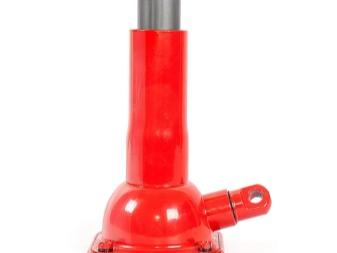
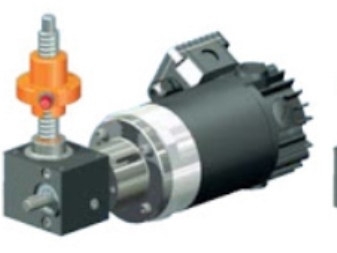
Rack jacks are needed to lift loads weighing up to 6 tons. A toothed rack with a swivel load head and a foot for lifting low-lying loads moves in the body. This rack moves in the housing with the help of a rack gear, and that, in turn, receives rotation from the handle through one or two pairs of gears. In order to keep the load in a raised position, a ratchet with a pawl is attached to the handle shaft.
Hydraulic units have a lifting capacity of up to 200 tons, they are indispensable for the installation of heavy construction and production equipment, as well as metal structures. At the same time, the lifting height reaches 0.15-0.2 m.The piston in them moves in the functional cylinder under the action of the hydraulic fluid, during its movement from the chamber to the cylinder under the action of the piston and gear pump. The piston lift is controlled through the spool valve of the distributor or some other device; for lowering the piston, a channel is provided that connects the working cylinder to the chamber.
When lifting loads weighing several thousand tons, usually several such jacks are connected at once into a common battery, feeding them from one common pump. In recent years, hydraulic jacks of this special design have been widely used for tensioning reinforcement during the manufacture of stress-reinforced concrete products.
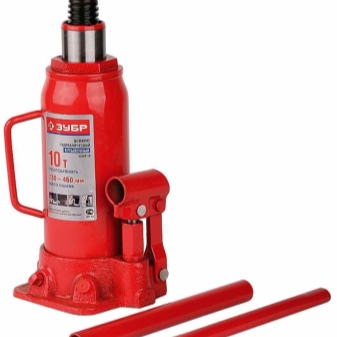

Pneumatic units are a symbiosis of a compressor, as well as a membrane elastic container, in which compressed air is supplied. Such installations are in demand in the course of emergency and rescue operations, they are used when dismantling debris, in traffic accidents and in other emergencies.
Appointment
The use of a jack in the construction of monolithic buildings is explained by the action of multidirectional loads. This mechanism is indispensable in almost all formwork systems that are used to fill horizontal, vertical, and volumetric structures. The basic function of the jack in this case is to ensure maximum stability of the entire structure. In addition, it can be used for alignment, fixing and separation of the formwork system during the pouring of the slabs. Only in horizontal structures all the functionality of construction jacks is revealed to the maximum extent.
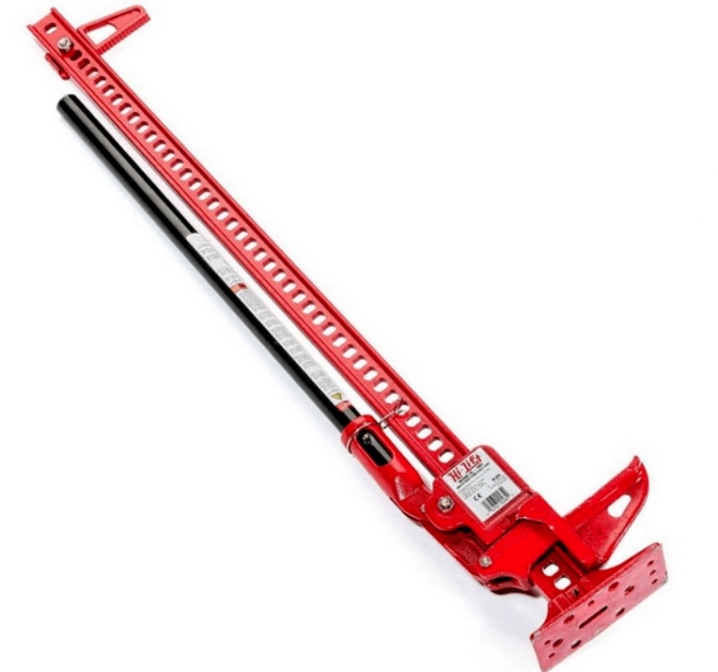
Selection rules
When choosing any construction jack, first of all, the following factors matter:
- minimum pick-up height,
- maximum lifting height,
- loading capacity of the device.
Parameters such as minimum pick-up height indicate the starting working height. The lower this parameter is, the more versatile the jack itself will be, which means that it can be used for a wide range of construction projects.

The maximum lifting height is also considered one of the most important parameters that you need to pay attention to when buying a construction jack. For most devices, this parameter is in the range from 30 to 50 cm
As a rule, this is quite enough to create conditions for access to a particular building surface and move it to the level of the scaffolding.
In the next video, you will learn how to choose the right jack.
Telescopic supports and their varieties
In particular, the distinctive features of the supports relate to the mechanism for changing their length. Currently, the following varieties are found:
- supports with a jack rotating around the axis;
- supports with pin mechanism;
- fixtures with a screw height adjustment device (screw supports).
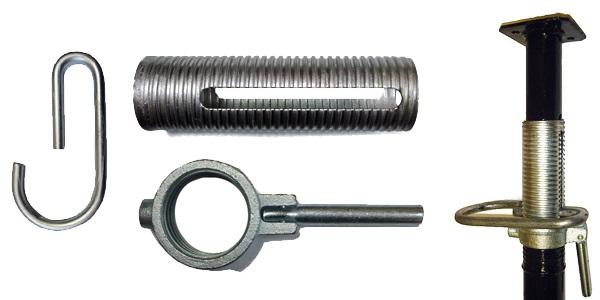
Screw support for formwork stand
Each of the product modifications has its own pros and cons. So, the version with a jack provides easy access to the adjusting mechanism, but the adjustment process itself is fraught with some difficulties arising from the need to rotate the mechanism elements around the support axis. The disadvantage becomes especially noticeable in cases where it is required to increase the height of the already assembled formwork.
Performance characteristics and scope
Và± øÃÂà° àÃÂà° à± þÃÂÃÂàüþÃÂ'ÃÂμà»Ã Ã¿Ã¾ÃÂ'úþÃÂà°, ÃÂÃÂþøàþà± ÃÂà° ÃÂøÃÂàòýøüà° ýøÃÂμ ýà° üà° ÃÂúøÃÂþòúÃÂ, à¸Ã¼ÃÂμýýþ þýà° ÃÂúà° à· ÃÂòà° ÃÂμàýà° ÃÂà° à± þÃÂøù ÃÂ'øà° ÿà° à· þý ÃÂ'à° ýýþóþ ÃÂà»ÃÂμüÃÂμýÃÂà°.áÃÂà° ýÃÂ'à° ÃÂÃÂýà° àüà° ÃÂúøÃÂþòúà° òÃÂóà»ÃÂÃÂ'øàÃÂû ÃÂμÃÂ'ÃÂÃÂÃÂøü þà± ÃÂà° à· þü: L 12 ü à ¢  ÃÂ'à° ýýþÃÂμ à· ýà° ÃÂÃÂμýøÃÂμ óþòþÃÂøàþà± à° úÃÂÃÂà° à»ÃÂýþÃÂÃÂø øÃÂÿþû ÃÂà· þòà° ýøàÿþÃÂ'úþÃÂà° ÿÃÂø ÃÂà° à± þÃÂÃÂμ àþà¿Ã ° à»ÃÂà± úþù, òÃÂÃÂþÃÂà° úþÃÂþÃÂþù ýÃÂμ üÃÂμýÃÂμÃÂμ 11,4 üÃÂμÃÂÃÂþò ø ýÃÂμ à± þû ÃÂμÃÂμ 12,3 üÃÂμÃÂÃÂþò. ÃÂÃÂÃÂÃÂÃÂμÃÂà° ÃÂÃÂÃÂàÿþÃÂ'úþÃÂÃÂ, üà° ÃÂúøÃÂþòà° ýýÃÂÃÂμ ÃÂà»ÃÂμÃÂ'ÃÂÃÂÃÂøü þà± ÃÂà° à· þü: L 14 ü, L 10 ü, L 8 ü ø ÃÂ.ÃÂ'.
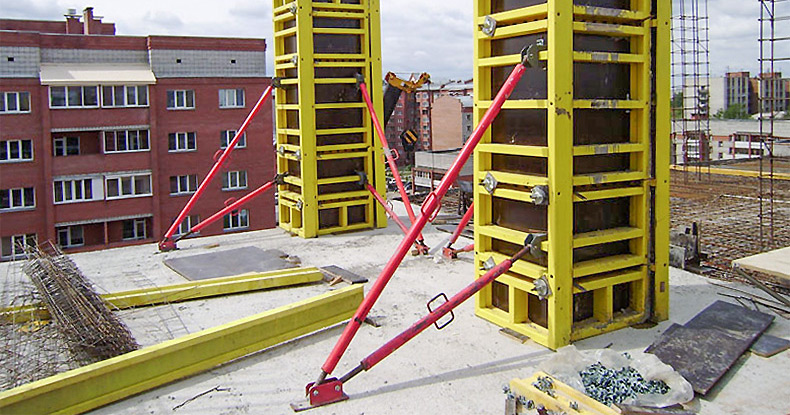
ÃÂÃÂøüÃÂμýÃÂμýøÃÂμ ÃÂ'òÃÂÃÂÃÂÃÂþòýÃÂμòÃÂàÿþÃÂ'úþÃÂþò ÿÃÂø òþà· òÃÂμÃÂ'ÃÂμýøø þÿà° à»ÃÂà± úø ÃÂ'û àÃÂÃÂÃÂþøÃÂÃÂμà»ÃÂÃÂÃÂòà° úþû þýý
09.11.2016
Structural features of the jack stand
The jack stand, used in the installation of the floor formwork, consists of such parts as: supports (lower and upper), nut, retainer and unilk. The lower part of the rack is stationary, it ends with a support having a surface area sufficient for stable fixation. The upper part is retractable, also equipped with a support that interacts with the elements of the formwork table, such as an I-beam.
Main technical characteristics of racks-jacks
| Name | Height | Diameterexternal support | Diameterinternal support | Load,minimum departure | Load,maximum reach |
| SD 3.1 | 1.7 m - 3.1 m | 60 mm | 48 mm (51 mm) | 4719 - 6991 kg | 1435 - 2593 kg |
| SD 3.7 | 2.0 m - 3.7 m | 60 mm | 48 mm (51 mm) | 3805 - 6670 kg | 1027 - 3580 kg |
| SD 4.2 | 2.5 m - 4.2 m | 60 mm | 48 mm (51 mm) | 2593 - 6132 kg | 860 - 3057 kg |
| SD 4.5 | 2.8 m - 4.5 m | 60 mm | 48 mm (51 mm) | 2079 - 5706 kg | 673 - 2593 kg |
The maximum rack height (with the inner tube fully extended) is 5 meters. To fill the floors located at the maximum height, the stand is reinforced with a tripod, which also allows for high-quality centering of the structure. In general, the installation of a formwork jack is not considered a very difficult process, it is enough to prepare the site, install a tripod, align its supports and fasten it to the rack using a fixing mechanism, after which the height is adjusted.



